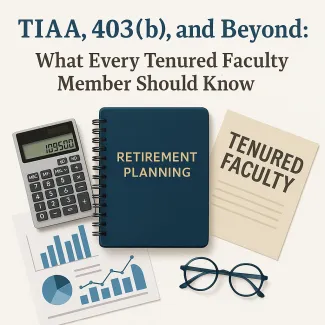
TIAA, 403(b), and Beyond: What Every Tenured Faculty Member Should Know
You've achieved tenure — the academic milestone that represents both security and freedom. But have you given your retirement accounts the same thoughtful scrutiny you apply to your research?
After 17 years inside TIAA, I've seen how even brilliant faculty members miss crucial opportunities hidden within their retirement benefits. The truth? Your 403(b) is likely the most powerful — and most misunderstood — financial tool in your academic arsenal.
Many tenured faculty fall into the same costly traps:
- Leaving employer matches unclaimed
- Overlooking the strategic power of a 457(b) supplement
- Missing critical decision points during sabbaticals, promotions, or major grant funding milestones
Most concerning? Very few understand the special distribution options available exclusively to higher education professionals — advantages that simply don’t exist in corporate retirement plans.
🔎 Did you know?
- TIAA Traditional contracts reward long-term participants with unique “vintage” interest rates that can dramatically boost retirement income.
- The TIAA Real Estate Account provides direct commercial real estate exposure — a rare asset class most retirement plans don’t offer.
These aren’t just incremental advantages. They can represent hundreds of thousands of dollars in additional retirement value over the course of your career. These 2 TIAA investment opportunities should be considered, among the other options available to you when creating and implementing your retirement plan
And beyond your core retirement accounts lies a constellation of often-overlooked benefits:
- Phased retirement options
- Unused sick leave conversions
- Retiree healthcare bridges
Each of these can profoundly shape your retirement trajectory — if you know how to integrate them.
Having guided hundreds of professors through these decisions, I've learned that financial success in academia isn’t about chasing complex investment schemes. It's about strategically aligning your institutional benefits with your intellectual capital — and preparing not only for the expected milestones, but also for life's inevitable surprises.
Quick Tip:
If you have multiple 403(b) accounts from different institutions, consolidating them can give you access to lower-cost institutional share classes — saving 0.5% to 0.75% annually in fees. Over time, that’s the kind of quiet optimization that could add years to your retirement funding.
🔔 If you found this helpful:
- Share it with a colleague who deserves better than “set-it-and-forget-it” retirement planning.
- Reach out if you want to map out a financial strategy that’s as intentional as your academic work.
Your financial life deserves the same rigor as your scholarship.
Advisory services offered through NewEdge Advisors, LLC, a registered investment adviser. Advisory services are only offered to clients or prospective clients where NewEdge Advisors and its representatives are properly licensed or exempt from licensure.
This material is for informational purposes only and does not constitute investment, tax, or legal advice. Past performance is not indicative of future results. Investing involves risk and possible loss of principal capital. No advice may be rendered by NewEdge Advisors unless a client service agreement is in place.
California Residents: We take protecting your data and privacy very seriously. As of January 1, 2020, the California Consumer Privacy Act (CCPA) provides additional rights to residents of California. You may view our data privacy statement or exercise your rights here: Do not sell my personal information

